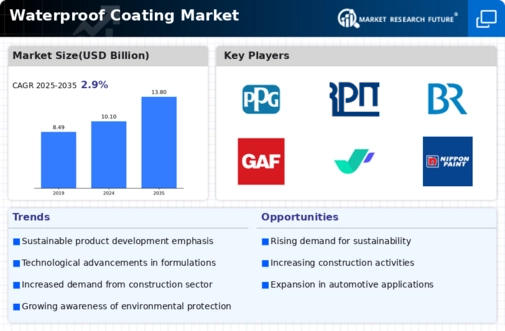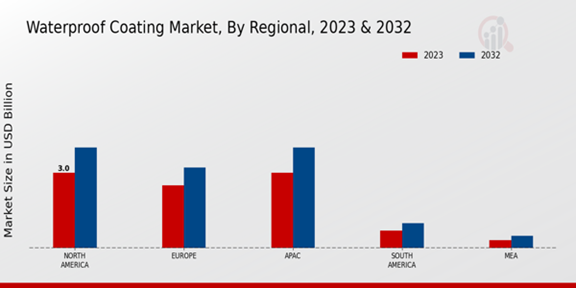Market Growth Projection
The Global Waterproof Coating Market Industry is projected to experience steady growth, with a market value anticipated to reach 10.1 USD Billion in 2024 and 13.8 USD Billion by 2035. The compound annual growth rate (CAGR) of 2.89% from 2025 to 2035 indicates a consistent upward trajectory. This growth is influenced by various factors, including technological advancements, increased awareness of water damage prevention, and regulatory support for sustainable practices. As the market evolves, stakeholders are likely to adapt to changing consumer preferences and environmental considerations, fostering a dynamic landscape for waterproof coating solutions.
Growing Construction and Renovation Activities
The Global Waterproof Coating Market Industry is propelled by the ongoing growth in construction and renovation activities globally. As urban centers expand and infrastructure projects gain momentum, the demand for waterproof coatings is expected to rise. This trend is particularly pronounced in developing regions where rapid urbanization is taking place. For example, new residential and commercial projects often require effective waterproofing solutions to ensure structural integrity. The increasing investment in infrastructure development is likely to bolster the market, as stakeholders recognize the importance of protective coatings in enhancing the durability of buildings and other structures.
Increased Awareness of Water Damage Prevention
The Global Waterproof Coating Market Industry benefits from heightened awareness regarding the prevention of water damage among property owners and builders. As the consequences of water infiltration become more widely recognized, stakeholders are more inclined to invest in waterproofing solutions. This awareness is particularly evident in regions prone to heavy rainfall and flooding, where waterproof coatings are viewed as essential for safeguarding properties. The growing emphasis on preventive measures is expected to contribute to the market's expansion, as consumers seek reliable solutions to mitigate potential damage. Consequently, this trend may lead to increased sales and adoption of waterproof coatings across various sectors.
Technological Advancements in Coating Solutions
Technological advancements play a crucial role in shaping the Global Waterproof Coating Market Industry. Innovations in formulation and application techniques have led to the development of more effective and environmentally friendly waterproof coatings. For example, the introduction of nanotechnology in coatings enhances their performance and durability. These advancements not only improve the product's efficacy but also align with global sustainability goals. As a result, manufacturers are increasingly investing in research and development to create superior products that meet the evolving needs of consumers. This focus on innovation is likely to drive market growth and expand the range of applications for waterproof coatings.
Rising Demand for Durable Construction Materials
The Global Waterproof Coating Market Industry experiences a notable surge in demand for durable construction materials, driven by the increasing focus on infrastructure development. As urbanization accelerates, the need for protective coatings that enhance the longevity of structures becomes paramount. For instance, waterproof coatings are essential in preventing water damage in buildings, bridges, and roads. This trend is reflected in the projected market value of 10.1 USD Billion in 2024, with expectations to reach 13.8 USD Billion by 2035. The compound annual growth rate (CAGR) of 2.89% from 2025 to 2035 indicates a sustained interest in high-performance coatings that can withstand environmental challenges.
Regulatory Support for Sustainable Building Practices
Regulatory frameworks promoting sustainable building practices significantly influence the Global Waterproof Coating Market Industry. Governments worldwide are implementing stringent regulations aimed at reducing environmental impact and enhancing energy efficiency in construction. These regulations often encourage the use of eco-friendly waterproof coatings that comply with sustainability standards. For instance, initiatives that mandate the use of low-VOC (volatile organic compounds) coatings are becoming more prevalent. Such regulations not only drive demand for compliant products but also foster innovation within the industry. As a result, manufacturers are motivated to develop sustainable solutions that align with regulatory requirements, thereby expanding their market reach.















